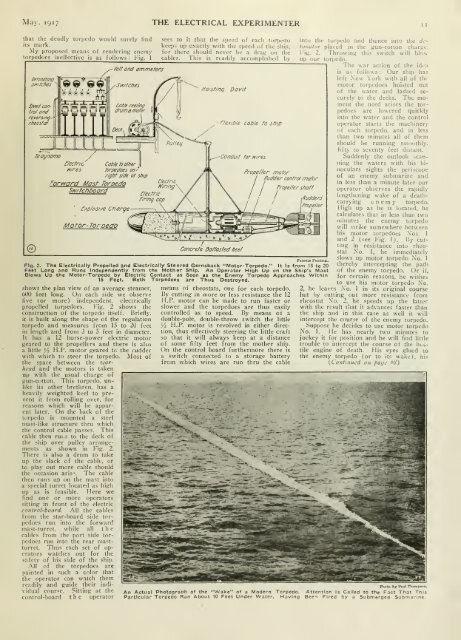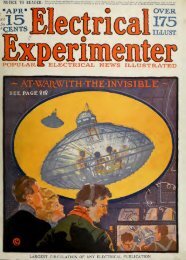The Electrical experimenter
The Electrical experimenter
The Electrical experimenter
Create successful ePaper yourself
Turn your PDF publications into a flip-book with our unique Google optimized e-Paper software.
Mav, 1917 THE ELECTRICAL EXPERIMENTER 1<br />
that the deadly torpedo would surely find<br />
its mark.<br />
My proposed means of rendering enemy<br />
torpedoes ineffective is as follows : h'tg. 1<br />
Defonafjng<br />
jmMes ^<br />
^ ® g) «) (i)<br />
rflT<br />
nn.<br />
It<br />
Speed control<br />
ond<br />
rei/eningrheoitat<br />
. "<br />
, m "<br />
,<br />
©<br />
- yo/f and ammefers<br />
Tadynomo /<br />
Clecfnc '<br />
Coble to oilier<br />
/f/rei torpedoes on^'<br />
right side of ship<br />
^orivard Mo5t Torpedo<br />
Siv//chboord<br />
CAplosive Cnarge<br />
Motor- Torpedo<br />
sees to it that the speed of each torpedo<br />
keeps up exactly with the speed of the ship,<br />
for there should never be a drag on the<br />
cal)Ics This is readily accomplished by<br />
Hoisting Davit<br />
Concrete Ballasted Ireel<br />
Fle/iible coble to snip<br />
Conduit tor ivires<br />
Profie/kr motor<br />
Rudder control motor<br />
Propeller shaft<br />
Rudders<br />
Propeller<br />
Patents I'endins-<br />
Fig. 2. <strong>The</strong> <strong>Electrical</strong>ly Propelled and <strong>Electrical</strong>ly Steered Gernsback "Motor- Torpedo." It Is from 15 to 20<br />
Feet Long and Runs Independently from the Mother Ship. An Operator High Up on the Ship's Mast<br />
Blows Up the Motor-Torpedo by Electric Contact as Soon as the Enemy Torpedo Approaches Within<br />
15 Feet. Both Torpedoes are Thus Destroyed.<br />
shows the plan view of an average steamer,<br />
600 feet long. On each side we observe<br />
five (or more) independent, electrically<br />
propelled torpedoes. Fig. 2 shows the<br />
construction of the torpedo itself. Briefly,<br />
it is built along the shape of the regulation<br />
torpedo and measures from 15 to 20 feet<br />
in length and from 3 to 5 feet in diameter.<br />
It has a 12 horse-power electric motor<br />
geared to the propellers and there is also<br />
a little .14 H.P. motor geared to the rudder<br />
with which to steer the torpedo. Most of<br />
the space between the -marhead<br />
and the motors is taken<br />
up with the usual charge of<br />
gun-cotton. This torpedo, unlike<br />
its other brethren, has a<br />
heavily weighted keel to prevent<br />
it from rolling over, for<br />
reasons which will be apparent<br />
later. On the back of the<br />
torpedo is mounted a steel<br />
mast-like structure thru which<br />
the control cable passes. This<br />
cable then rui.s to the deck of<br />
the ship over pulley arrangements<br />
as shown in Fig. 2.<br />
<strong>The</strong>re is also a drum to take<br />
up the slack of the cable, or<br />
to play out more cable should<br />
the occasion aris". <strong>The</strong> cable<br />
then runs up on the mast into<br />
a special turret located as high<br />
up as is feasible. Here we<br />
find one or more operators<br />
sitting in front of the electric<br />
control-board. .Ml the cables<br />
from the star-board side torpedoes<br />
run into the forward<br />
mast-turret, while all the<br />
cables from the port side torpedoes<br />
run into the rear mastturret.<br />
Thus each set of operators<br />
watches out for the<br />
safety of his side of the ship.<br />
.Ml of the torpedoes are<br />
painted in such a color that<br />
the operator can watch them<br />
readily and guide their indi-<br />
vidual course. Sitting at the<br />
control-board the operator<br />
means of rheostats, one for each torpedo.<br />
By cutting in more or less resistance the 12<br />
H.P. motor can be made to run faster or<br />
slower and the torpedoes are thus easily<br />
controlled as to speed. By means of a<br />
double-pole, double-throw switch the little<br />
|j H.P. motor is revolved in either direction,<br />
thus effectively steering the little craft<br />
so that it will always keep at a distance<br />
of some fifty feet from the mother ship.<br />
On the control board furthermore there is<br />
a switch connected to a storage battery<br />
from which wires are run thru the cable<br />
into the torpedo and thence into tlic dclonalur<br />
placed in the gun-cotton charge,<br />
h'ig. 2. Throwing this switch will blowup<br />
our torpedo.<br />
<strong>The</strong> war action of the idea<br />
is as follows: Our ship has<br />
left New York with all of the<br />
motor torpedoes hoisted out<br />
of the water and lashed securely<br />
to the decks. <strong>The</strong> moment<br />
the need arises the torpedoes<br />
are lowered quickly<br />
into the water and the control<br />
operator starts the machinery<br />
of each torpedo, and in less<br />
than two minutes all of them<br />
should be running smi»thly.<br />
fifty to seventy feet distant.<br />
Suddenly the outlook scanning<br />
the waters with his binoculars<br />
sights the periscope<br />
of an enemy submarine and<br />
in less than a minute later our<br />
operator observes the rapidly<br />
lengthening wake of a deathcarrying<br />
enemy torijedo.<br />
High up as he is located, he<br />
calculates that in less than two<br />
minutes the enemy torpedo<br />
will strike somewhere between<br />
his motor torpedoes .Vos. 1<br />
and 2 (see I-"ig. \). By cutting<br />
ill resistance into rheostat<br />
Xo. 1, he immediately<br />
slows up motor torpedo Xo. 1<br />
thereby intercepting the path<br />
of the enemy torpedo. Or if,<br />
for certain reasons, he wishes<br />
to use his motor torpedo .\'o.<br />
2, he leaves Xo. 1<br />
but by cutting out<br />
in its original course<br />
more resistance from<br />
rheostat Xo. 2, he speeds up the latter<br />
with the result that it advances faster than<br />
the ship and in this case as well it will<br />
intercept the cnurse of the enemy torpedo.<br />
Suppose he decides to use motor torpedo<br />
No. 1. He has nearly two minutes to<br />
jockey it for position and he will find little<br />
trouble to intercept the course of the hc




